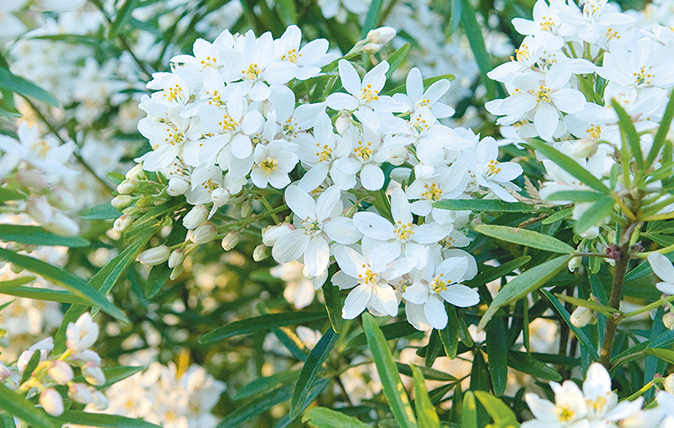How to get over box blight
If you’re frustrated with box blight, there are some alternatives to consider


By Alan Titchmarsh
After the winter deluge, I find myself stock-taking and trying not to be too impatient digging up things that are missing, presumed drowned. A poke around reveals either a sturdy subterranean rootstock or something more akin to chicken soup, so, in either case, at least I know where I am and whether or not I can cut my losses and brood on suitable replacements.
The brooding has stopped with box. One or two patches have resisted box blight a clone bought as Faulkner has been particularly resilient but the majority of plants, many of them clipped into topiary specimens, have become badly disfigured, as if carelessly blasted with a flame- thrower. I’ve read of many treatments, all of which seem to involve frequent chemical applications.
As well as being an organic gardener, I’m unwilling to have a garden that requires regular forays with a knapsack sprayer. Where is the pleasure in ‘a spray programme’? Where box is used as low, formal hedging, I’m now ripping it out and replacing it.
Our drive was flanked with a rolling main of box clipped into billowing clouds, rather after the fashion of William Kent’s ocean of laurel at Rousham, although much lower. For several years, it looked impressive. Then, each autumn for the past five years or so, patches of it have looked as if they have been sprayed with creosote brown at first and then crisp and denuded of green growth.
Having experimented by replacing part of this plantation with Choisya ternata last year, I’m going the whole hog this spring and replacing the rest of it. Choisya looks good in summer (two lots of fragrant white flowers, first in April and again in September, and wonderfully fresh green growth) and it provides another visual treat in winter when its fingered leaves are rimed with frost. Yes, it grows taller and wider than dwarf box, but, alongside the drive, I have the height and width to accommodate it and it’s also tolerant of clipping I know this as I’ve seen it used as a formal hedge.
My small sea of box can now become an ocean of Mexican orange blossom much hardier than its common name would suggest.
Exquisite houses, the beauty of Nature, and how to get the most from your life, straight to your inbox.
Elsewhere, I’ve replaced dwarf hedges of Buxus sempervirens Suffruticosa with Ilex crenata (a little yellow in its extremities at first, but, now, one year on, rich-green and glossy) and, around a raised circular pond, with Euonymus japonicus Jean Hugues, which grows rather taller and has new leaves of fresh green, darkening with age. Both of these replacements look promising and I shall certainly not plant any more box until the breeders have come up with a strain that has proven resistance to blight.
A brief spell of frost in January did for the echiums in our Hampshire garden: so much for the ‘soft South’. I have yet to get them though a winter out- doors on the mainland except by digging them up in September, potting them, watching them wilt for a fortnight before they pick up and overwintering them in a frost-free greenhouse, before replanting them outdoors in April.
However, in our garden on the Isle of Wight, they have come through great, bold-green rosettes that will hopefully produce those tall spires of blue bugloss flowers the bees love. Echiums grow like weeds in Ventnor Botanic Garden on the south coast of the island, but I was unsure whether that mildness would pertain on the north coast in Cowes. So far, it has and I now hold my breath, fearful of a late cold snap that might put them at risk.
Despite its lofty aerial growth, Echium pininana seems to have a modest root system. One or two have perished in our island garden due to the sticky clay at their feet, but ‘mound planting’ on a heap of grittier earth will hopefully ensure them a brighter future.
Beginning a new garden (and our island garden is only two years old) is an exhilarating challenge rewarding and disappointing by turns. However, discovering just a handful of plants that have been hitherto impossible to grow in prevailing conditions fires any gardener with renewed enthusiasm. It is, after all, what keeps us fresh.
Country Life is unlike any other magazine: the only glossy weekly on the newsstand and the only magazine that has been guest-edited by His Majesty The King not once, but twice. It is a celebration of modern rural life and all its diverse joys and pleasures — that was first published in Queen Victoria's Diamond Jubilee year. Our eclectic mixture of witty and informative content — from the most up-to-date property news and commentary and a coveted glimpse inside some of the UK's best houses and gardens, to gardening, the arts and interior design, written by experts in their field — still cannot be found in print or online, anywhere else.
-
 What on earth is the person who comes up with Annabel's otherworldly facade displays on? London's most magical Christmas shop displays
What on earth is the person who comes up with Annabel's otherworldly facade displays on? London's most magical Christmas shop displaysPhotographs by Greg Funnell.
-
 What trees taught me about perfect planting — Alan Titchmarsh
What trees taught me about perfect planting — Alan TitchmarshSense and patience is key to growing healthy trees, as a certain Mr Mackenzie showed a young Alan Titchmarsh
